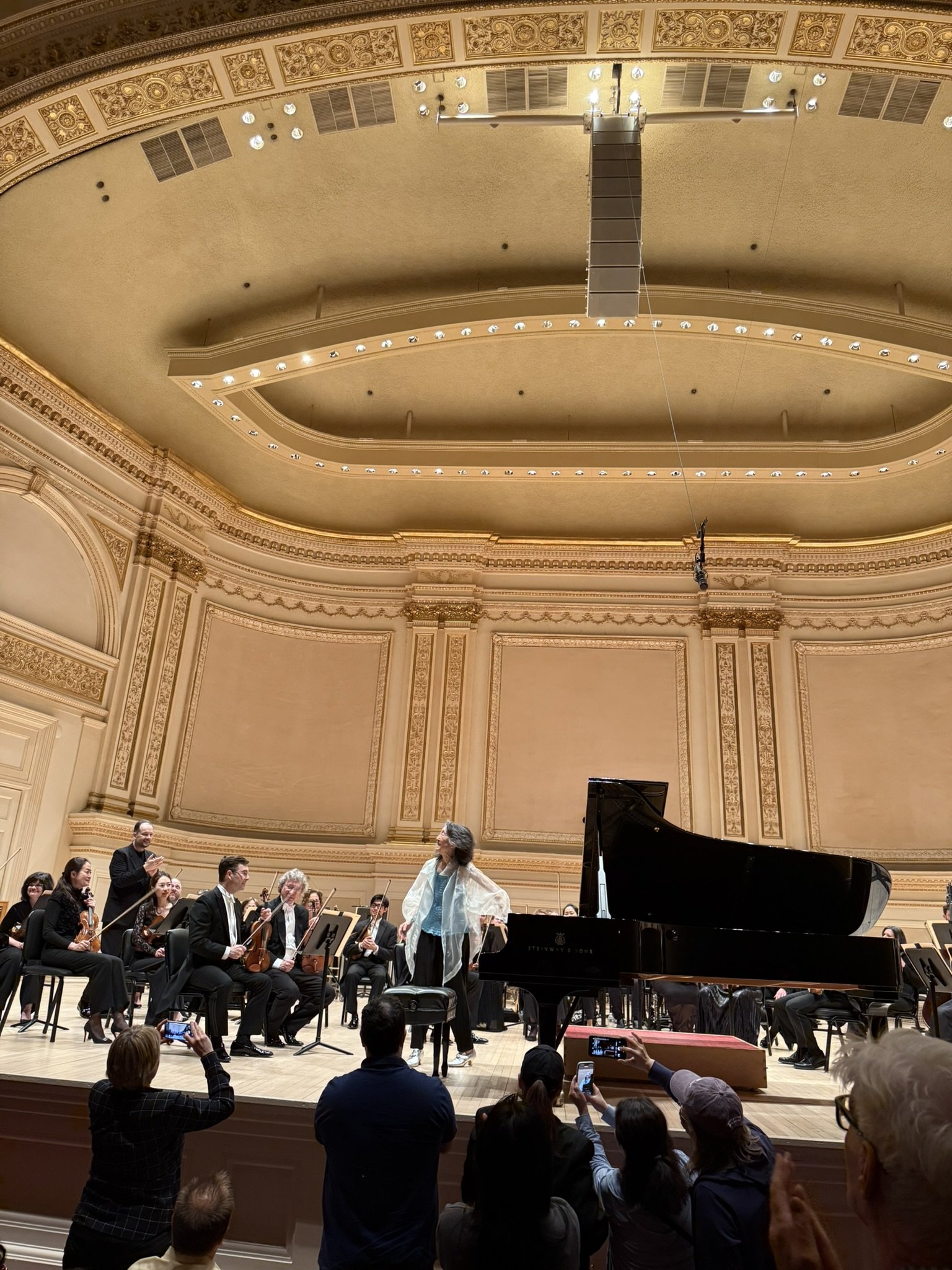Boston Symphony Orchestra and its music director, Andris Nelsons, held a concert at Carnegie Hall on April 23rd. The first piece was Beethoven's Piano Concerto No. 4, with Mitsuko Uchida as solo piano. The program notes said that the piece prominently depicts issues of power and domination and contains connotations of struggle and competition, which intrigued me. This piece was performed in 1808 on the same day as Symphony No. 5, known for its Fate motif. However, in contrast to the concise and powerful symphony, the Fate motif in No. 4 begins with a soft, quiet, and clear solo piano. Uchida's deep concentration on the sound gives the impression of silent resignation or strong determination. A positive and peaceful struggle. Walking quietly with a big walking stick (support). I felt strongly the atmosphere of Kurtág that I heard in the second half of the solo recital the other day. Fate spreads to the orchestra and develops as arpeggios and variations on the scale. Solo and orchestra. Individual and society. Uchida and Boston's quiet concentration. After the cadenza, the orchestra's theme faintly sounds. It's a little awkward but not unpleasant. I think this is who we are now. Instead, it's fragile and fragile. It's as if we're searching for our place in the world. In the second movement, Andante, the piano quietly responds to and accompanies the orchestra's Dias Ire (Day of Wrath) theme. It fades out quietly from Una Corda and moves on to the third movement. However, it is not a brilliant performance, but rather a Beethoven that can be called the abyss of Boston and Uchida. It is a performance that observes the bubbles that arise when loneliness and dissatisfaction are poured into water and finds a way out of them. But things happen and disappear—the universe. The three-year perspective on Mitsuko Uchida's tenure at Carnegie Hall has come to an end. In the second half, Shostakovich's last Symphony No. 15 was performed. It is the last symphony written in 1971 by a composer who realized that he was near death. There are also abstract references, and you can feel Shostakovich's overflowing imagination and creative energy. The first movement is a toy shop at midnight, the second is a lament, the third is a grotesque wind ensemble, and the fourth is a string serenade on the theme of Wagner's Siegfried. The theme appears intermittently, and at the end, in a harmony reminiscent of Mahler's Symphony No. 1, percussion instruments such as celestas and snare drums, as well as flutes and xylophones, appear one after another, and the curtain closes as if casting a spell. Shostakovich's wonderland, which continued to be created in Moscow under the Stalin regime, has something in common with the mysterious world of David Lynch. Throughout the concert, the impression of Boston was not about rhythm, vocals, or music but about an exchange of hearts and the phenomenon itself. The sharing of values that Nelsons and Boston have cultivated over the years. The technique and fun of the new members and veterans were the very essence of Boston.
ボストン交響楽団と音楽監督アンドリス・ネルソンスが4月23日にカーネギーホールでコンサートを行った。1曲目はベートーヴェンのピアノ協奏曲第4番で、ピアノは内田光子。プログラムノートには、この曲には権力と支配の問題が顕著に表れており、協奏の意味には闘争や競争の意味合いを内包していると書かれていて興味をそそられた。この曲は1808年、運命の曲で知られる交響曲第5番と同じ日に演奏された。しかし、簡潔で力強い交響曲とは対照的に、第4番の運命のモチーフは柔らかく静かで澄んだソロピアノで始まる。内田の音への深い集中は、静かな諦念、あるいは強い決意の印象を与える。前向きで静かな闘い。大きな杖(支え)を持って静かに歩む。先日のソロ・リサイタルの後半で聴いたクルタークの雰囲気を、私は強く感じた。その運命はオーケストラにも伝播し、アルペジオや音階の変奏として展開していく。ソロとオーケストラ。個人と社会。内田とボストンの静かな集中。カデンツァの後、オーケストラのテーマがかすかに響く。少しぎこちないが不快感はない。これが今の私たちなのだと思う。むしろ、はかなく脆い。まるで世界の中で居場所を探しているかのようだ。第2楽章アンダンテでは、オーケストラのディアス・イレ(怒りの日)のテーマにピアノが静かに応答し、伴奏する。ウナ・コルダから静かにフェードアウトし第3楽章へ。しかし、華麗な演奏ではなく、ボストンと内田の深淵とも言えるベートーヴェン。水に孤独や不満を注ぎ込んだ時に生じる泡を観察しその活路を見出すような演奏。しかし、事は起こり、消えていく森羅万象。カーネギーホールでの3年に渡る内田光子特集が終わった。後半はショスタコーヴィチ最後の交響曲第15番。死期を悟った作曲家が1971年に書いた最後の交響曲。抽象的な言及もあり、ショスタコーヴィチの溢れんばかりの発想力と創作の勢いを感じる。第1楽章は深夜の玩具屋、第2楽章は哀歌、第3楽章はグロテスクな木管アンサンブル、そして第4楽章はワーグナーのジークフリートの主題による弦楽セレナーデ。主題は断続的に現れ、最後はマーラーの交響曲第1番のような和声の中、チェレスタやスネアドラムといった打楽器、フルートやシロフォンの主題が次々と現れ、呪文を唱えるように幕を閉じる。スターリン体制下のモスクワで創造され続けたショスタコーヴィチのワンダーランドは、デヴィッド・リンチの神秘的な世界に通じる。コンサートを通して、ボストンの印象はリズムや歌唱、音楽ではなく、心の交流、そして現象そのものだった。ネルソンスとボストンが長年培ってきた価値観の共有。新メンバーとベテランの技巧と楽しさは、まさにボストンの真髄だった。
Boston Symphony Orchestra
Andris Nelsons, Music Director and Conductor
Mitsuko Uchida, Piano
Program
BEETHOVEN Piano Concerto No. 4
SHOSTAKOVICH Symphony No. 15
New and Old faces togeter on Shostakovich’s 15th Symphony on Carnegie Hall



